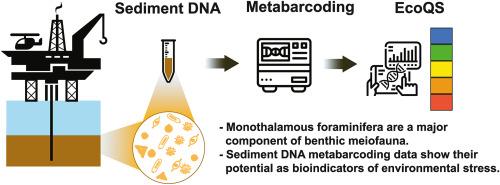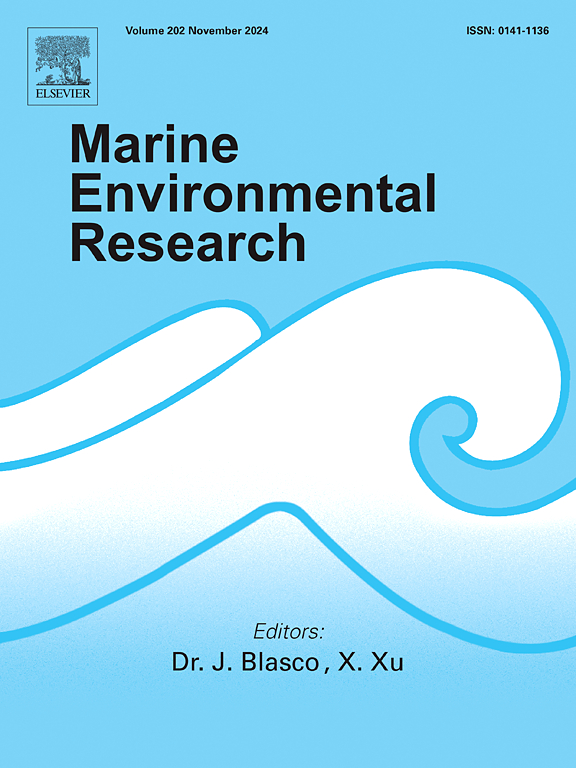Monothalamous foraminifera are useful bioindicators for DNA-based benthic monitoring of North Sea offshore platforms
IF 3.2
3区 环境科学与生态学
Q2 ENVIRONMENTAL SCIENCES
引用次数: 0
Abstract
Benthic foraminifera are widely recognized as excellent bioindicators for assessing the Ecological Quality Status (EcoQS) of marine environments. However, most of the current foraminiferal biomonitoring is based on hard-shelled taxa. Here, we analyze soft-walled monothalamous foraminifera in sedimentary environmental DNA metabarcoding data to assess the EcoQS and the response of the benthic community to impacts associated with the activity of an offshore platform in the North Sea, based on two-year sampling campaigns. Our results confirm the dominance of monothalamids in the metabarcoding data and indicate that their diversity tends to increase with distance from the platform. We also calibrated and tested an ecological index based on foraminiferal ecological indices, foram-gAMBI, to assess the EcoQS. The foram-gAMBI is significantly and strongly correlated to most metals, hydrocarbons (r = 0.74–0.92, p < 0.05), and moderately correlated with organic matter (r = 0.48–0.55, p < 0.05). The correlation values are higher than those found for the macrofauna-based AMBI and nematode-gAMBI, supporting the higher sensitivity of foram-gAMBI to environmental stress. The EcoQS assignment based on four ecological indices shows a very high agreement and consistency among them. The classification of stations into three impact classes according to selected environmental variables (Ba, Zn, Cu, THC) allows the identification of some monothalamids as indicators of high or low impact. Our study provides new evidence of the usefulness of foraminiferal metabarcoding for monitoring anthropogenic impacts and highlights the need to include monothalamids among foraminiferal bioindicators.

单thalamous有孔虫是有用的生物指标,以dna为基础的海底监测北海海上平台
底栖有孔虫被广泛认为是评估海洋环境生态质量状况(EcoQS)的优秀生物指标。然而,目前大多数有孔虫生物监测是基于硬壳类的。在这里,我们分析了沉积环境DNA元条形码数据中的软壁单thalamous有孔虫,以评估EcoQS和底栖生物群落对北海海上平台活动相关影响的响应,基于两年的采样活动。我们的结果证实了单丘脑在元条形码数据中的优势地位,并表明它们的多样性倾向于随着距离平台的距离而增加。我们还校准并测试了基于有孔虫生态指数的生态指数foram-gAMBI,以评估EcoQS。有孔am- gambi与大多数金属、碳氢化合物显著且强相关(r = 0.74-0.92, p < 0.05),与有机质中度相关(r = 0.48-0.55, p < 0.05)。相关值高于大型动物AMBI和线虫gambi,支持有孔虫gambi对环境胁迫的更高敏感性。基于四个生态指标的EcoQS分配结果具有很高的一致性和一致性。根据选定的环境变量(Ba、Zn、Cu、THC)将监测站分为三个影响等级,从而可以确定一些单丘脑类物质作为高影响或低影响的指标。我们的研究为有孔虫元条形码在监测人为影响方面的有用性提供了新的证据,并强调了将单丘脑类生物指标纳入有孔虫生物指标的必要性。
本文章由计算机程序翻译,如有差异,请以英文原文为准。
求助全文
约1分钟内获得全文
求助全文
来源期刊

Marine environmental research
环境科学-毒理学
CiteScore
5.90
自引率
3.00%
发文量
217
审稿时长
46 days
期刊介绍:
Marine Environmental Research publishes original research papers on chemical, physical, and biological interactions in the oceans and coastal waters. The journal serves as a forum for new information on biology, chemistry, and toxicology and syntheses that advance understanding of marine environmental processes.
Submission of multidisciplinary studies is encouraged. Studies that utilize experimental approaches to clarify the roles of anthropogenic and natural causes of changes in marine ecosystems are especially welcome, as are those studies that represent new developments of a theoretical or conceptual aspect of marine science. All papers published in this journal are reviewed by qualified peers prior to acceptance and publication. Examples of topics considered to be appropriate for the journal include, but are not limited to, the following:
– The extent, persistence, and consequences of change and the recovery from such change in natural marine systems
– The biochemical, physiological, and ecological consequences of contaminants to marine organisms and ecosystems
– The biogeochemistry of naturally occurring and anthropogenic substances
– Models that describe and predict the above processes
– Monitoring studies, to the extent that their results provide new information on functional processes
– Methodological papers describing improved quantitative techniques for the marine sciences.
 求助内容:
求助内容: 应助结果提醒方式:
应助结果提醒方式:


